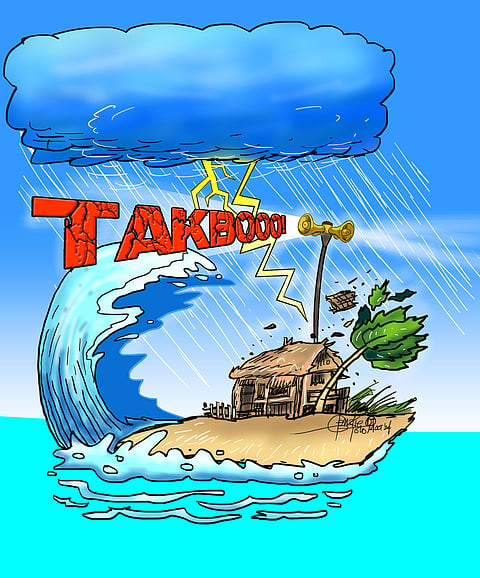
- NEWS
- the EDIT
- COMMENTARY
- BUSINESS
- LIFE
- SHOW
- ACTION
- GLOBAL GOALS
- SNAPS
- DYARYO TIRADA
- MORE

The Philippines is no stranger to natural calamities. Positioned within the Pacific Ring of Fire, it is vulnerable to frequent earthquakes and volcanic eruptions. Adding to this precarious geography is the fact that the country faces an average of 20 typhoons annually, many of which bring devastating floods and landslides.
Given this harsh reality, the International Day for Disaster Risk Reduction which was commemorated yesterday, 13 October, serves as a crucial reminder for Filipinos to reflect on the importance of disaster preparedness. It is not enough to simply react to disasters; proactive measures are needed to build a more resilient nation capable of reducing the impact of these natural hazards.
One of the most critical components in disaster risk reduction is the implementation of robust early warning systems. In recent years, the Philippine Atmospheric, Geophysical and Astronomical Services Administration and the Philippine Institute of Volcanology and Seismology have made strides in improving disaster forecasting.
However, there is still room for improvement. Investing in more advanced technology to provide accurate and timely information to communities in high-risk areas can save lives. Better communication networks, including mobile alerts, community radio, and social media, should be leveraged to ensure that even the most remote communities are informed about impending disasters.
While technology is crucial, early warning systems must also be coupled with educational campaigns. Schools, local governments and NGOs can collaborate on training programs that teach people how to interpret warnings and respond accordingly. Information alone is insufficient if the public lacks the knowledge on how to act.
For instance, knowing how to evacuate, prepare a survival kit and find safe areas can mean the difference between life and death.
Another key strategy in reducing disaster risks is ensuring that infrastructure is resilient. The government has already implemented building codes designed to withstand earthquakes and typhoons, but enforcement remains inconsistent, especially in rural areas.
Local governments should prioritize enforcing these codes to ensure that new structures, including schools and hospitals, are built to endure extreme conditions. For communities already living in high-risk zones, relocation programs must be designed and implemented effectively. Informal settlers, in particular, are often the most affected by natural disasters due to their vulnerable housing situations.
Government programs aimed at relocating people from these hazardous areas must be paired with support systems that provide alternative housing, livelihood opportunities, and access to essential services. This way, relocation becomes a sustainable solution rather than a temporary band-aid solution.
Community involvement is at the heart of effective disaster risk reduction. While national and local government agencies play significant roles in large-scale preparedness and response efforts, communities themselves must be empowered to take action. Establishing local disaster risk reduction committees and equipping them with knowledge, tools, and resources to handle emergencies can significantly mitigate the impact of disasters.
For instance, barangays can organize disaster drills to simulate evacuation during typhoons or earthquakes. These drills not only help residents practice escape routes and safety measures but also foster a sense of collective responsibility and preparedness. Communities can also create localized early warning systems, such as flags or sirens, for areas where mobile connectivity might be unreliable.
Moreover, fostering solidarity between neighboring communities can enhance overall resilience. During times of crisis, mutual aid networks that facilitate resource sharing, from food to medical supplies, can prevent small-scale disasters from escalating into larger humanitarian crises.
In recent years, the increasing severity of typhoons has been linked to climate change, making the need for climate action more urgent. The Philippines, though a relatively small contributor to global carbon emissions, bears the brunt of climate-related disasters. Advocating for international climate justice while implementing local environmental policies is essential.
The government should invest in renewable energy sources, reduce deforestation, and improve waste management systems, all of which contribute to mitigating climate change. Engaging communities in reforestation programs, such as planting mangroves in coastal areas, can help protect against storm surges and flooding.
As the International Day for Disaster Risk Reduction approaches, the Philippines must acknowledge its vulnerability to natural disasters while also recognizing its capacity for resilience.
While the country cannot stop typhoons from forming or earthquakes from striking, it can minimize their impact and protect the lives and livelihoods of its people.
By preparing today, the Philippines can stand a stronger tomorrow.
